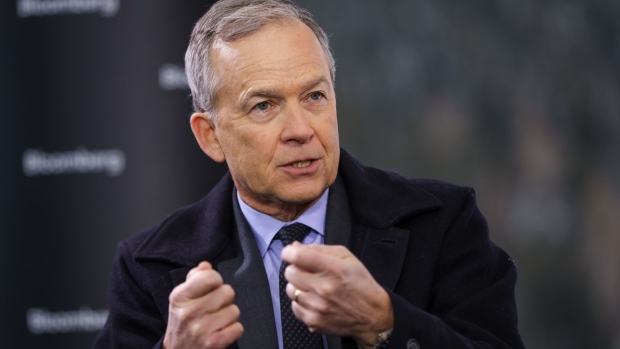风萧萧_Frank
以文会友桥水警告美国通胀斗争远未结束
July 14, 023
https://www.ft.com/content/3489c43d-83ff-413b-9477-dd6c042211f2
联合投资主管鲍勃·普林斯表示,美联储不太可能实现市场预期的快速降息

鲍勃·普林斯表示,紧缩政策“可以采取在面对降息预期时保持利率稳定的形式”。
全球顶级对冲基金之一的投资主管警告称,美国与通胀的斗争远未结束,押注美联储明年一系列快速降息还为时过早。
桥水联合首席投资官鲍勃·普林斯(Bob Prince)的言论给本周全球股市和债市的涨势泼了一盆冷水,数据显示美国年度通胀率已降至两年多低点,引发了这一涨势。 6 月份为 3%。
管理着1250亿美元资产的桥水基金的普林斯表示,市场认为美联储将很快放松货币政策的假设是错误的。 “美联储不会降息,”他告诉英国《金融时报》。 “他们不会按照定价去做。”
期货市场的定价表明,投资者预计到秋季,美联储的利率目标范围将在 5% 至 5.25% 的基础上进一步上调 0.25 个百分点。 他们预计央行将在接下来的 12 个月内扭转局面,到 2024 年 11 月将借贷成本削减六倍至 3.8% 左右。
在本周的通胀数据公布后,交易员加大了对降息的押注。 尽管总体通胀率大幅下降,但核心通胀率(不包括波动较大的食品和能源行业,受到美联储密切关注)下降速度较慢,降至 4.8%。 尤其是核心利率仍远高于美联储 2% 的既定目标。
普林斯表示:“通胀已经下降,但仍然过高,而且可能会趋于平稳——我们可能会陷入这个通胀水平。” 他补充说,“目前最大的风险是,当工资仍然强劲时,能源价格就会反弹”,这可能会推动通胀反弹。
Prince 与联席首席信息官 Karen Karniol-Tambour 和 Greg Jensen 一起负责这家康涅狄格州公司的资产管理,他表示,他认为核心通胀率可能会触底反弹至 3.5% 至 4% 之间,从而推动美联储进一步收紧货币政策,令投资者失望。 他本周将美国股市推至一年多以来的最高水平。
他表示,紧缩政策“可以采取在降息预期下保持利率稳定的形式”。
对美联储将很快结束其历史性紧缩周期的预期推动了全年市场的乐观情绪。 美国两大股指——标准普尔 500 指数和以科技股为主的纳斯达克综合指数——今年已脱离熊市,分别上涨 16.5% 和 33%。 债券回报率更加低迷,彭博全球综合指数今年上涨了2.4%,但投资者因希望美联储紧缩政策即将结束而锁定了数十年来的最高收益率。
即便如此,普林斯表示,“目前普遍持有债券或股票资产并不是一个好的环境”,并补充说现金目前是一种有吸引力的选择。
他表示,桥水基金已经“为紧缩周期做好了准备”,这意味着对风险较高的资产类别采取谨慎立场。
“我们今年的表现接近持平。 一月初我们出现了一些下滑,但从那以后我们已经逐渐恢复过来。” 他没有讨论该公司两个主要策略的具体业绩数据:其 Pure Alpha 基金(传统的宏观基金)或其风险平价全天候基金。
普林斯表示,美联储将不得不在更长时间内维持较高利率,因为其通胀斗争在一定程度上受到强劲劳动力市场的阻碍。 Covid-19大流行初期的财政和货币计划帮助增加了家庭储蓄,但也使劳动力市场收紧,导致工资大幅上涨。 这意味着美国消费者的收入更高,使他们能够继续承受价格上涨的影响。
普林斯表示:“目前的支出水平是由收入提供资金,而不是信贷扩张。” “所以通货膨胀确实很难降低。”

布里奇沃特王子表示,必须减少更多工作岗位才能抑制通货膨胀
Nishant Kumar 和 Lisa Abramowicz,彭博新闻
1 月 17 日,鲍勃·普林斯 (Bob Prince) 在达沃斯。摄影师:Hollie Adams/Bloomberg
1 月 17 日,鲍勃·普林斯 (Bob Prince) 在达沃斯。摄影师:Hollie Adams/Bloomberg, Bloomberg
(彭博社)——帮助管理全球最大对冲基金的鲍勃·普林斯(Bob Prince)表示,我们正在看到繁荣-萧条周期的回归,在通胀得到控制之前,需要有更多的人失业。
桥水联合首席投资官普林斯在瑞士达沃斯世界经济论坛上接受彭博电视采访时表示,“很难说我们是否已经结束紧缩政策,或者是否还会再次紧缩政策。” “我们可以说的是,下一个落脚点必定是经济下滑,特别是劳动力市场收缩。”
普林斯表示,交易员的表现仍然像是美联储将重复对之前经济低迷的反应,从而提振股价。 “被低估的是对过去十年的回归,”他说。 “实际发生的情况更像是 20 世纪 70 年代。 更像是繁荣-萧条周期。”
他的预测与包括花旗集团的简·弗雷泽(Jane Fraser)在内的一些首席执行官在达沃斯其他地方关于温和衰退前景的言论背道而驰。 不过,普林斯表示,经济衰退的深度将取决于央行在多大程度上遏制通胀,以及企业在多大程度上控制自己的支出。
繁荣-萧条周期是指经济扩张和收缩不断重复。 自金融危机以来央行的干预以及过去十年大部分时间的货币宽松打破了这种模式并推动了市场繁荣。 普林斯本人在 2020 年达沃斯发表讲话时表示,繁荣-萧条的经济周期已经结束。
“我们正在经历美国和欧洲经济货币刺激的后遗症。 现在,钱在系统中旋转,从一个人到另一个人,”普林斯说。 “支出根本没有下降,还不足以降低通胀。”
这家总部位于康涅狄格州韦斯特波特的投资公司的 Pure Alpha II 基金在 10 月和 11 月因市场转向而损失了大部分年度收益后,去年收盘上涨了 9.5%。
Bridgewater's Prince Says More Jobs Must Vanish to Tame Inflation
Nishant Kumar and Lisa Abramowicz, Jan 17, 2023

Bob Prince in Davos on Jan. 17. Photographer: Hollie Adams/Bloomberg , Bloomberg
(Bloomberg) -- Bob Prince, who helps manage the world’s largest hedge fund, said we're seeing the return of the boom-bust cycle and more people need to lose their jobs before inflation will be brought under control.
“It is hard to say whether we are done with the tightening or we will have another tightening,” Prince, the co-chief investment officer of Bridgewater Associates, said in an interview with Bloomberg TV at the World Economic Forum in Davos, Switzerland. “What we can say is that the next shoe to drop has to be a decline in the economy, in particular, a contraction in the labor markets.”
Prince said traders were still acting like the Federal Reserve will repeat its response to previous downturns and therefore buoy stock prices. “What is discounted is a return to the last decade,” he said. “What is actually happening is more like the 1970s. More like the boom-bust cycle.”
His predictions run counter to what some CEOs including Citigroup Inc.’s Jane Fraser have been saying elsewhere at Davos about the prospects of a mild recession. Still, Prince said the depth of any downturn will depend on how far central banks go to counter inflation, and how much companies rein in their own spending.
The boom-bust cycle refers to economic expansion and contraction that repeats itself. Central bank intervention since the financial crisis and monetary easing for much of the last decade had disrupted that pattern and fueled a market boom. Speaking at Davos in 2020, Prince himself had said that boom-bust economic cycle was over.
“We are experiencing the after effects of the monetary stimulation of the US and European economies. Now the money is spinning around the system, exchanging hands from one to the next,” Prince said. “Spending has not fallen off hardly at all, not nearly enough to bring down inflation.”
The Westport, Connecticut-based investment firm’s Pure Alpha II fund ended last year up 9.5%, after losing much of its annual gains in October and November as markets turned.




